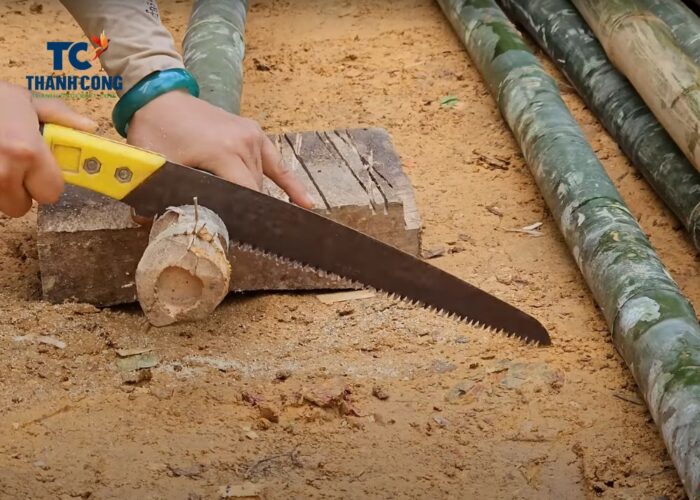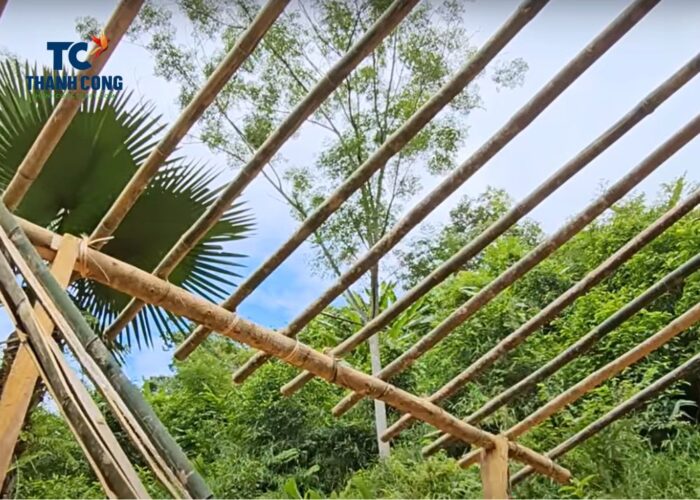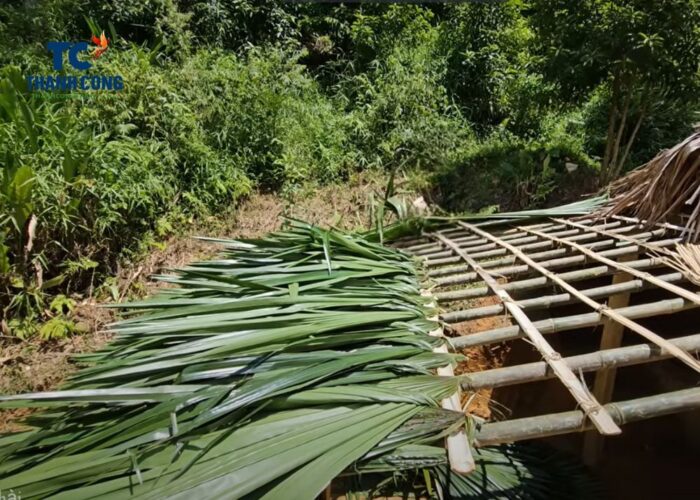A bamboo roof is an environmentally friendly, sustainable and cost-effective building solution. Bamboo is a fast-growing plant that has high strength and easy regeneration. To make a DIY bamboo roof, you need to prepare the necessary materials and tools, design the roof structure, install the bamboo frame and cover the roof. This article will guide you on how to build a bamboo roof in a simple way. Have a read!
1. How to build a bamboo roof?
A bamboo roof is an environmentally friendly, sustainable and cost-effective building solution. To build a bamboo roof, you need to prepare the following materials and tools:
- Bamboo: choose bamboo with a diameter of about 10-15 cm, with long and straight stems, without cracks or decay. You need about 20-30 bamboo trees depending on the size of the roof.
- Rope: choose a durable and flexible rope that can withstand load and weather. You need about 100-200 meters of rope depending on the size of the roof.
- Hooks: choose hooks that can withstand high stress, and can be attached to the frame or bamboo poles. You need about 10-20 hooks depending on the size of the roof.
- Saw, scissors, knife, hammer, ruler, pencil: the necessary tools to cut, measure and attach bamboo.
After preparing the materials and tools, you can start making your own DIY bamboo roof following these steps:
Step 1: Cut bamboo into segments
Cut bamboo into equal-length segments, about 2-3 meters. These will be the bamboo bars to make the roof frame. You need about 10-15 bamboo bars depending on the size of the roof.

Step 2: Attach bamboo bars to the existing frame
Attach the bamboo bars to the hooks that are already attached to the frame or bamboo poles. You should attach the bamboo bars so that they are parallel to each other and evenly spaced about 30-40 cm apart. You can use rope to tie the bamboo bars to the hooks.

Step 3: Use palm leaves to cover the roof
Cut the palm leaves into pieces with a width of about 10-15 cm. These will be the palm leaf pieces to cover the roof. You need about 100-200 palm leaf pieces depending on the size of the roof.
Step 4: Arrange the palm leaf pieces on the bamboo roof
Cover the roof with the cut palm leaf pieces. You should cover from bottom to top, from inside to outside, so that the palm leaf pieces overlap each other at least half of their width. You can use rope to tie the palm leaf pieces to the bamboo bars..

Step 5: Check and finalize
Check the stability and tightness of the roof. You can add or remove palm leaf pieces if necessary. You should also check the rope ties and hooks to ensure safety.
2. FAQs
2.1 What are the disadvantages of bamboo roofing?
While bamboo roofing offers several advantages, it also has some disadvantages that should be considered:
- Durability: Bamboo may not be as durable as traditional roofing materials like metal or concrete. Over time, it can be susceptible to decay, insect infestations, and weathering, especially in harsh climates.
- Vulnerability to Pests: Bamboo is organic and can attract insects and pests, leading to potential infestations. Proper treatment and maintenance are necessary to prevent these issues.
- Limited Load-Bearing Capacity: Bamboo has limitations in terms of its load-bearing capacity. It may not be suitable for heavy loads, making it less ideal for large or multi-story structures.
- Maintenance Requirements: Regular maintenance is essential to preserve the integrity of bamboo roofing. This includes treatments to prevent decay, inspections for pest infestations, and occasional replacement of damaged bamboo.
- Fire Resistance: Bamboo is not naturally fire-resistant. This can be a significant disadvantage in areas prone to wildfires or where fire safety is a crucial consideration. Fire-retardant treatments may be applied, but they may need periodic reapplication.
- Limited Design Options: Compared to conventional roofing materials, bamboo may offer fewer design options. Achieving certain architectural styles or complex roof designs may be challenging with bamboo.
2.2 How long will a bamboo roof last?
A bamboo roof can last from 10 to 20 years if it is treated against termites, mold and fire. However, the lifespan of a bamboo roof can vary based on several factors, including the quality of the bamboo, the climate in which it is installed, and the level of maintenance it receives.
- Quality of Bamboo: The type and quality of bamboo used play a significant role in determining the roof’s longevity. Durable and treated bamboo, as well as species known for their strength, can contribute to a longer lifespan.
- Climate: The environmental conditions, such as humidity, exposure to sunlight, and extremes in temperature, can impact the durability of bamboo. In areas with harsh weather conditions, the roof may experience more wear and tear.
- Treatment and Maintenance: Proper treatment and regular maintenance are crucial for extending the lifespan of a bamboo roof. This includes applying protective coatings to prevent decay, addressing pest issues promptly, and replacing damaged bamboo as needed.
- Installation Quality: The skill and expertise with which the bamboo roof is installed can influence its durability. A well-constructed roof with proper support structures and secure fastening is more likely to last longer.
- Exposure to Elements: The degree to which the bamboo roof is exposed to the elements, such as heavy rains, strong winds, or direct sunlight, can affect its longevity. Adequate protection and shelter can help mitigate potential damage.
2.3 How do you waterproof a bamboo roof?
Bamboo is a type of plant with natural water-resistant properties, but if not treated properly, it can become prone to decay and water absorption. Some ways to make a bamboo roof more waterproof include:
- Use Water-Resistant Coatings: Apply water-resistant paints or surface coatings that also provide resistance against insects and UV rays. Painting or coating the outer layer of bamboo poles enhances their durability and heat resistance.
- Utilize Lining Materials or Underlayment: Use lining materials or underlayment beneath the bamboo roof, such as banana leaves, palm leaves, rattan, non-woven fabric, or nylon. These materials help prevent water infiltration into the interior of the bamboo roof, creating an insulating layer.
- Incorporate Sloped Structures or Designs: Design the bamboo roof with high slopes, pyramid shapes, or hexagonal designs. These structures facilitate faster water runoff, preventing water from pooling on the roof.
In conclusion, understanding how to build a bamboo roof requires careful consideration of various factors, ranging from the selection of quality bamboo to the implementation of effective waterproofing techniques. By doing so, you not only create a functional and aesthetically pleasing structure but also contribute to sustainable and eco-friendly building practices.
If you have any further questions, don’t hesitate to send thanhcongcraft an email us at info@thanhcongcraft.com or message us at WhatsApp: +84967485411. Hope to serve you soon! Best regard!












